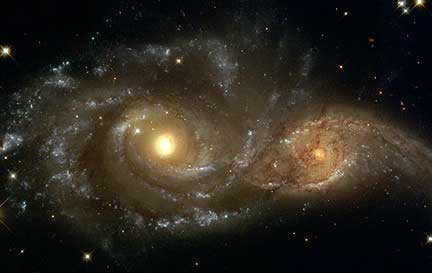
|
Galaxies are on the move, drifting through space. Occasionally they collide. In this case, the two galaxies just missed each other, coming to their closest point of approach some 40 million years ago. The main point of interest for our present purpose is how the brownish gas/dust lanes of the larger galaxy (NGC 2207) show up best where they are in front of the smaller galaxy on the right (IC 2163). Remembering that at this distance most stars are too small to see distinctly, these clots of dusty gas are huge! It turns out that although the galaxies missed each other this time, they are moving by each other so slowly that they will not escape each other's gravity. They will continue to orbit each other until at some point billions of years from now they will merge to form a single massive galaxy. Next Image!Image credit: Hubble Space Telescope; The main source for HST images and explanations is HubbleSite.org. |
|
|
|
